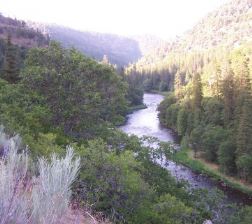|
Klamath-JC
Boyle Dam
Photo essay by
Katherine and Steve Pedery
|
|
The Klamath River flows some 250
miles from Upper Klamath Lake and the high desert
of Southern Oregon to spill into the Pacific Ocean
amid the foggy redwoods of California’s North
Coast. Along the way it carves a path through an
incredibly diverse landscape, including a remote
and wild canyon just north of the Oregon-California
border.
|
|

The Klamath
suffers from a variety of
environmental woes, the largest of which is chronic
low water flows due to irrigation diversions in its
headwaters and tributaries. A series of dams along
the river, owned by Pacificorps (which in turn is
owned by Scottish Power), add to the river’s
problems.
|
|
|
Klamath
River
clear water
stretch
This shot is from the 6
mile stretch of the Klamath River de-watered by JC
Boyle Dam. Here the Klamath River looks more like a
small creek than a major waterway. The only water
flowing in the riverbed at this point is from
springs in the canyon walls, and a small amount
being spilled from the dam’s fish passage
structures.
|
|
|
|
KlamathRiver-Clearwater
redband
A native redband trout from the
section of the Klamath de-watered by Boyle Dam.
Cold springwater allows a good population small
trout to survive in this section of the river. Much
larger fish can be found in the fully watered
section of the Klamath River.
|
|
|
|
|
|
|
Klamath
River-Clearwater
salmonfly
Despite the poor condition of
the Klamath River below Boyle it still supports an
array of insect life, including giant salmon flies
like this one.
|
|
|
|
|
The JC Boyle
Dam
project chokes flows in
the Klamath River roughly a dozen miles north of
the California border. It diverts nearly the entire
flow of the Klamath into a series of pipes and
flumes, nearly de-watering a 6 mile stretch of the
river, before running the water through turbines
and dumping it back into the channel. Because the
dam is used for “peaking”, meaning it essentially
turns flows through the turbines and into the river
on and off based on electricity demand, the Boyle
Project causes serious harm to native fish and
wildlife downstream
|
|
|
|
.
|
Boyle Dam
Channel and pipe
On the left side of the picture
is John C. Boyle Dam, on the right is the pipe
through which the water of the Klamath River now
flows. The natural channel of the river is in the
foreground.
|
|
|
|
Boyle-Dam
dry channel
Another shot of the natural bed
of the Klamath River at the base of JC Boyle Dam.
Note the algae growing in the hot water.
|
|
|
|
Boyle
flume
After piping the flow of the
Klamath River across the natural river channel, the
JC Boyle Dam project diverts the water into this
concrete flume, where it flows hundreds of feet
above the natural bed of the river.
|
|
|
|
|
Boyle flume
pumphouse
At the end of the flume, water
enters this pumping facility where it is pumped
through a mountain.
|
|
|
|
Boyle pipes
After passing the water through
a mountain, the JC Boyle Dam project diverts almost
the entire flow of the Klamath River through these
giant pipes to generate electricity.
|
|
|
|
|
|
|
Boyle
Pipes
The giant pipes feed the water
of the Klamath River down the side of a mountain
and through the turbines of the Boyle powerhouse
before allowing the water to flow once again in the
natural river channel. The channel curves upstream
to the right of the powerhouse.
|
|
|
|
Boyle
turbines
The electricity generating
turbines at the powerhouse of JC Boyle Dam. Boyle
produces a fairly small amount of electricity, but
causes serious harm to the river.
|
|
|
|
Boyle Dam
dry channel
This photo shows the natural
channel of the Klamath River at the base of JC
Boyle Dam. The trickle of water flowing through it
is leaking through the dam.
|
|
|
|
Boyle
Dam
fishladder
These photos show the primitive
fish ladder at Boyle Dam, as well as the nitrate
foam and algae blooms in the pool at the base of
the ladder. This area is far from hospitable to
redband trout and other native fish.
|
|
|
|
|
|
Klamath
River-bathtub ring
The Klamath River below Boyle
Dam after the water has been “turned off”. Flows in
the Klamath swing wildly because of the dam. Note
the water line on the gravel, and the bathtub ring
on the rocks across the river.
|
|
|
|
|
Klamath
River
Below Boyle
Below the JC Boyle Dam project
the Klamath River flows through a rugged and scenic
canyon. The beauty of this area, and its importance
to fish and wildlife, is offset by the wildly
fluctuating river flows due to JC Boyle
Dam.
|
|
|
Return
to the
Klamath
Restoration Council
See our Salmon
Gallery
|
|
